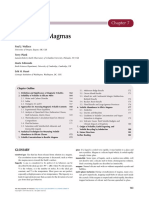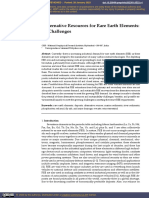Cfbs
Cfbs
Uploaded by
Devsamridhi AroraCopyright:
Available Formats
Cfbs
Cfbs
Uploaded by
Devsamridhi AroraOriginal Description:
Original Title
Copyright
Available Formats
Share this document
Did you find this document useful?
Is this content inappropriate?
Copyright:
Available Formats
Cfbs
Cfbs
Uploaded by
Devsamridhi AroraCopyright:
Available Formats
CONTINENTAL FLOOD BASALTS
WHAT ARE CONTINENTAL FLOOD BASALTS?
Tremendous outpourings of basaltic lavas, that have inundated local areas of the oceans and continents, amounting to largest igneous events on Earth, have been called large igneous provinces(LIPs).
The continental manifestations of these LIPs are called continental flood basalts(CFBs), or plateau basalts.
A more ancient term traps, meaning steps is ocassionally used to refer to them, because of the step like geomorphology of eroded flow layers.
The flows are unusually fluid and rapidly erupted, covering extensive areas with large volumes of magma.
Erosion in these volcanic piles has commonly revealed cogenetic mafic intrusions, including sills, dikes, and the more massive layered mafic intrusions.
MAP SHOWIN LARGE IGNEOU PROVINCES OVER THE WORLD
Province Columbia River Basalt Afro-Arabia North Atlantic Igneous Province
Region Northwestern USA Yemen-Ethiopia Northern Canada, Greenland, the Faeroe Islands, Norway, Ireland and Scotland India & southern Pakistan
Age (Ma) 17-to-6 31-to-25
Area (106 km2 0.16 0.6
Volume (106 km3 0.175 0.35
Also known as or includes
Ethiopia High Arctic Large Igneous Province Jameson Land Thulean Plateau
62-to-55
1.3
6.6
Deccan Traps Madagascar Rajmahal Traps Paran and Etendeka traps Karoo-Ferrar Province
65.5 88 116
0.5 - 0.8
0.5 - 1
BrazilNamibia South Africa, Antarctica, Australia & New Zealand Northern South America, Northwest Africa, Iberia, Eastern North America Russia Australia
134-to-129
1.5
>1
Equatorial Atlantic Magmatic Province Brazilian Highlands
183-to-180
0.15-to-2
0.3
Central Atlantic magmatic province Siberian Traps Warakurna large igneous province
197-to-199
~10
~2.5
250 1078-to-1073
1.5 - 3.9 1.5
0.9 - >2 Eastern Pilbara
AGE OF CONTINENTAL FLOOD BASALTS AND ITS SIGNIFICANCE
Major continental flood basalt provinces occur in the Proterozoic, the Early Cambrian, the Late Permian-Early Jurassic, the Late Triassic-Early Jurassic, the Late Jurassic-Early Cretaceous, the Late Cretaceous-Late Eocene, the Palaeocene-Eocene, the Eocene-Miocene, the Eocene/Miocene/ Middle Pleistocene, and the Miocene.
The virtual absence of continental flood basalts from the Palaeozoic is puzzling for uniformitarian geologists.
Continental flood basalts are thought to originate when a continental rift system coincides with a mantle plume. If this is the case, why did no continental flood basalts form throughout the Palaeozoic?
It is suggested that continental flood basalts could not form in the Palaeozoic because they require subaerial conditions and the continents were flooded at that time.
TECTONIC SETTINGS OF CFBs
There are three major hypotheses for the origin of continental flood basalts, associated with the following tectonic settings: 1) Continental rifting. 2) Mantle plumes. 3) Back-arc spreading.
CFBs RELATED TO CONTINENTAL RIFTING
Dfficult to determine which leads to which, but both attributed to some deep seated thermal instability.
CFBs may be associated with failed rifts i.e those that do not lead to new oceanslike the Keweenawan province and Siberian traps. LIPs and CFBs also associated with incipient stages of successful continental rifting the Parana, Karoo, North Atlantic and Antarctic provinces occurred in sites undergoing continental fragmentation that led to the opening of the Atlantic and Indian Oceans. However, not all continental rifts are loci of CFBs, suggesting that a mantle hot spot plume is a necessary component of magmatism. A deep plume, tapping the sub-660km enriched mantle could also explain the alkaline character of some CFB material.
CFBs RELATED TO MANTLE PLUMES
Mantle plumes, or hot spots, are commonly associated with continental break-up, and arenow recognized as principal cause of LIPs.
The Parana and Etendeka provinces are of an age and position to have been located over the Tristan hotspot at the time of initial development and rifting in the South Atlantic.
The combination of rifting and plume development result in exceptionally high thermal output, which result in the local development of CFBs.
In case of Deccan Traps, the period of intense igneous activity post dated the rifting activity between India and Africa by 50Ma. Plate tectonic reconstructions for the period of flood volcanism put the Deccan area near or over the hotspot now beneath the Reunion Island.
In this case, hotspot activity alone was apparently sufficient to generate this huge flood basalt province, but the period was also markedby the separation of India and Madagascar.
CFBs RELATED TO BACK ARC SPREADING
Columbia River Basalt Group is considered to be a result of back-arc spreadin behind the Cascade arc in a continental environment. This might be called failed back arc, because it never fully separated to an off-shore arc such as Japan with a marginal sea behind it. Such arcs, that retain most of their continental character, are called ensialic back arc basins. The thermal output of such a back arc system alone is not generally regarded as sufficient to generate the quantity of basalt found in CFB provinces. Thus, a plume is also suspected of taking part.
COMPOSITION OF CONTINENTAL FLOOD BASALTS
Tholeiitic basalts are the dominant magma type in continental flood basalts. But more evolved differentiates and alkaline types are also represented. Although picrites (intrusive igneous rock of ultramafic (very silica-poor) composition that is composed largely of olivine and augite and is somewhat similar to peridotite) do occur in some CFBs, the magmas are generally evolved.
Non-picritic flows are characteristically high in Si, Fe, Ti and K. Mg# is commonly less than 60.
Compatible trace element contents, such as Ni and Cr, are low, suggesting that CFBs are not primary magmas, but have undergone substantial crystal fractionation prior to eruption.
GEOCHEMICAL VARIATION IN CFBs
Magma reservoir ponded at the base of the crust was proposed as a site for low pressure fractional crystallization of plagioclase, olivine and pyroxene, which can explain the evolved nature of CFBs. In areas of extension, the crust is thinner, forming a natural collectin point for ascending magma. Alternatively, a plume head could cause extension. Plumes may stall at the base of the more rigid lithospheric mantle, but the density of primary magma s suggests that they should pond at the top of the mantle, beneath the less dense continental crust. Shallow fractional crystallizatin woul take place here, plus some assimilation of the lower crust, either until the density changed enough so that the magmas were once again bouyant enough to rise further, or extensional faults provided conduits for the escape and rise of dense mafic liquids. CFBs are also characterized by high concentrations of in compatible trace elements, particularly K2O, LIL and LREE.
THUS, GEOCHEMICAL VARIATION IN CONTINENTAL FLOOD BASALTS IS THE RESULT OF DIFFERENCES IN THE DEGREE OF PARTIAL MELTING,POLYBARIC FRACTIONAL CRYSTALLIZATION, MAGMA MIXING, CRUSTAL CONTAMINATION, AND DIFFERENT CHARACTERISTICS. NO OCCURRENCE OF CFBs CAN BE SIMPLY MODELED IN A TEMPORAL SENSE BY ANY ONE OR ANY PAIR OF THE ABOVE PROCESSES.
THANK YOU.
You might also like
- Trond H. Torsvik, L. Robin M. Cocks - Earth History and Palaeogeography-Cambridge University Press (2017)Document324 pagesTrond H. Torsvik, L. Robin M. Cocks - Earth History and Palaeogeography-Cambridge University Press (2017)Augusto Dietrich SchmitzNo ratings yet
- Earth - S Internal Heat Source & MagmatismDocument26 pagesEarth - S Internal Heat Source & MagmatismAngela Nicole Nobleta88% (8)
- Geology Wallula GapDocument112 pagesGeology Wallula GapPaleogeneNo ratings yet
- Ogfj201601 DLDocument68 pagesOgfj201601 DLJasgeoNo ratings yet
- WORKING WITH MIGMATITES Mineralogical Association of Canada Short Course Series Volume 38Document168 pagesWORKING WITH MIGMATITES Mineralogical Association of Canada Short Course Series Volume 38Walter Cruz MermaNo ratings yet
- Rock Forming Minerals in Thin SectionDocument235 pagesRock Forming Minerals in Thin Sectionyaku16180% (1)
- Offshore Sydney Basin Eastern Australia: EnvoiDocument6 pagesOffshore Sydney Basin Eastern Australia: EnvoiAbang GaffiNo ratings yet
- OCS 1005 Exam 1Document96 pagesOCS 1005 Exam 1Jashayla GillespieNo ratings yet
- Fugro ThesisDocument174 pagesFugro ThesisImran SiddiquiNo ratings yet
- Chapter 15: Continental Flood BasaltsDocument19 pagesChapter 15: Continental Flood BasaltsAnonymous N5cRd2S9dxNo ratings yet
- The Volcanic and Magmatic Evolution of Volc N Ollag e A High K Late Quaternary Stratovolcano in The Andean Central Volcanic ZoneDocument25 pagesThe Volcanic and Magmatic Evolution of Volc N Ollag e A High K Late Quaternary Stratovolcano in The Andean Central Volcanic ZoneGustavo MaureiraNo ratings yet
- Magmatic DifferentiationDocument6 pagesMagmatic DifferentiationEbenezerSherlockAyiteyNo ratings yet
- Diagenesis & LithificationDocument15 pagesDiagenesis & LithificationDann PerezNo ratings yet
- Clay MineralsDocument17 pagesClay Mineralsyash saragiyaNo ratings yet
- Arribas 1995 MinAssocCanada23Document33 pagesArribas 1995 MinAssocCanada23Muhammad AriansyahNo ratings yet
- Chapter 7. Volatiles in MagmasDocument21 pagesChapter 7. Volatiles in MagmasViridiana CruzNo ratings yet
- Time in Porphyry Cu - Au Development Corbett - Pacrim 2019 - BDocument5 pagesTime in Porphyry Cu - Au Development Corbett - Pacrim 2019 - BHumberto SalvadorNo ratings yet
- Introduction To Ophiolites Rock FormationsDocument8 pagesIntroduction To Ophiolites Rock FormationsApriadi DediNo ratings yet
- Detachment Fault Related MineralizationDocument5 pagesDetachment Fault Related MineralizationFatah. RNo ratings yet
- CMB 847Document107 pagesCMB 847ManuelNo ratings yet
- Algar Pindell 93trinidad - Northern - Range GeologyDocument16 pagesAlgar Pindell 93trinidad - Northern - Range Geologyrajal11No ratings yet
- Lithium Conference Abstract BookDocument39 pagesLithium Conference Abstract BookAyalew TebejeNo ratings yet
- Skarn DepositsDocument7 pagesSkarn Depositsrenaldo100% (1)
- Minerals of The Montmorillonite GroupDocument71 pagesMinerals of The Montmorillonite GroupjmcerveraaNo ratings yet
- Sillitoe 2015Document27 pagesSillitoe 2015Andre Gallegos100% (1)
- Iceland Rift PlatinumDocument26 pagesIceland Rift PlatinumJoseph RaziNo ratings yet
- Sillitoe - Porphyry CopperDocument17 pagesSillitoe - Porphyry CopperAnonymous Dqc5FvngDNo ratings yet
- Petrographic Characteristics of Porphyry Indicator Minerals From Alkalic Porphyry Libre PDFDocument10 pagesPetrographic Characteristics of Porphyry Indicator Minerals From Alkalic Porphyry Libre PDFHenrry Chipana PomaNo ratings yet
- Ager - Derek - The Nature of Stratigraphical Record (3rd Edition-1993) PDFDocument82 pagesAger - Derek - The Nature of Stratigraphical Record (3rd Edition-1993) PDFGalaxad GarcíaNo ratings yet
- Petrology and Geochemistry of Granitic Rocks PDFDocument6 pagesPetrology and Geochemistry of Granitic Rocks PDFYodji Fufuri100% (1)
- Breccia Poster VancouverDocument48 pagesBreccia Poster Vancouverdeyvi santosNo ratings yet
- SDFFDocument67 pagesSDFFPreso ULNo ratings yet
- Barton09 CordilleranIOCG SGA PDFDocument3 pagesBarton09 CordilleranIOCG SGA PDFhidrogeolo_29No ratings yet
- A Geological Field Guide To Cooley, Gullion, Mourne Slieve CroobDocument106 pagesA Geological Field Guide To Cooley, Gullion, Mourne Slieve Croobjentmax9No ratings yet
- Controversies On The Origin of World-Class Gold Deposits Part I Carlin-Type Gold Deposits in Nevada PDFDocument9 pagesControversies On The Origin of World-Class Gold Deposits Part I Carlin-Type Gold Deposits in Nevada PDFjunior.geologiaNo ratings yet
- Dimension Stone: The Latest Trends in Exploration and Production TechnologyDocument36 pagesDimension Stone: The Latest Trends in Exploration and Production Technologytkujun9636No ratings yet
- Orthomagmatic CopperDocument4 pagesOrthomagmatic CopperDarrusalam UchihaNo ratings yet
- Goudie-Viles2015 Book LandscapesAndLandformsOfNamibiDocument164 pagesGoudie-Viles2015 Book LandscapesAndLandformsOfNamibiGaspar Bakos50% (2)
- Sedex VMSDocument12 pagesSedex VMSCarlos MaulNo ratings yet
- Migration Pathways of HydrocarbonDocument6 pagesMigration Pathways of HydrocarbonPetrus AdityaNo ratings yet
- Genesis Porphyry Moybdenum DepositsDocument34 pagesGenesis Porphyry Moybdenum DepositsEber Gamboa100% (1)
- Clays and Their Industrial Applications: Synoptic Review: S. O. Obaje, J. I. Omada and U. A. DambattaDocument7 pagesClays and Their Industrial Applications: Synoptic Review: S. O. Obaje, J. I. Omada and U. A. DambattaDamNo ratings yet
- Classification of Quartz Textures in Epithermal VeinsDocument7 pagesClassification of Quartz Textures in Epithermal VeinsJuan Enrique García RiveraNo ratings yet
- Macroseep Association With ProductionDocument1 pageMacroseep Association With ProductionKunal RathodNo ratings yet
- Balaram, 2023Document20 pagesBalaram, 2023andi febbyNo ratings yet
- KeslerDocument6 pagesKeslerLenin Gerardo Macas CamposNo ratings yet
- Classificação Carbonatos Embry & Klovan 1971Document52 pagesClassificação Carbonatos Embry & Klovan 1971monteiroNo ratings yet
- SeminarDocument1 pageSeminarStefan StankovićNo ratings yet
- Sequence Stratigraphy and Depositional Response To Eustatic, Tectonic and Climatic ForcingDocument390 pagesSequence Stratigraphy and Depositional Response To Eustatic, Tectonic and Climatic ForcingHadi Hashim100% (3)
- 2 Candela - Magmatic Processes in The Development of Porphyry-Type Ore SystemsDocument13 pages2 Candela - Magmatic Processes in The Development of Porphyry-Type Ore Systems作者月No ratings yet
- Richards (2003 EG) PDFDocument19 pagesRichards (2003 EG) PDFAlonzoNo ratings yet
- A Geochemical Classification For Granitic RocksDocument16 pagesA Geochemical Classification For Granitic RocksFitrah HaidirNo ratings yet
- Structural Setting and Shape Analysis of Nickel Sulfide Shoots at The Kambalda DomeDocument15 pagesStructural Setting and Shape Analysis of Nickel Sulfide Shoots at The Kambalda Domeflysch_ukNo ratings yet
- 2019 Corbett Staged Model For Porphyry DevelopmentDocument7 pages2019 Corbett Staged Model For Porphyry DevelopmentBro BroNo ratings yet
- Greenstone-Hosted Quartz-Carbonate Vein Deposits (Orogenic, Mesothermal, LodeDocument13 pagesGreenstone-Hosted Quartz-Carbonate Vein Deposits (Orogenic, Mesothermal, LodeCarlos Gallego100% (4)
- Geology of EgyptDocument725 pagesGeology of EgyptMisr RaymondNo ratings yet
- Bowens Reaction SeriesDocument9 pagesBowens Reaction SeriesManfinflaNo ratings yet
- Lithospheric DiscontinuitiesFrom EverandLithospheric DiscontinuitiesHuaiyu YuanNo ratings yet
- Santa Rita del Cobre: A Copper Mining Community in New MexicoFrom EverandSanta Rita del Cobre: A Copper Mining Community in New MexicoNo ratings yet
- Revealing the Invisible Mine: Social Complexities of an Undeveloped Mining ProjectFrom EverandRevealing the Invisible Mine: Social Complexities of an Undeveloped Mining ProjectNo ratings yet
- Mining Capital: Methods, Best-Practices and Case Studies for Financing Mining ProjectsFrom EverandMining Capital: Methods, Best-Practices and Case Studies for Financing Mining ProjectsNo ratings yet
- PEGMATITESDocument12 pagesPEGMATITESDevsamridhi AroraNo ratings yet
- Classification of Igneous RocksDocument12 pagesClassification of Igneous RocksDevsamridhi Arora100% (1)
- Porphyry DepositsDocument21 pagesPorphyry DepositsDevsamridhi AroraNo ratings yet
- PEGMATITESDocument12 pagesPEGMATITESDevsamridhi AroraNo ratings yet
- Ocean Land FormsDocument16 pagesOcean Land FormsDevsamridhi AroraNo ratings yet
- Geology of Middle EarthDocument10 pagesGeology of Middle Earthshawn_gaffneyNo ratings yet
- Increase Temperature Deep Ocean CrustDocument186 pagesIncrease Temperature Deep Ocean CrustVincent J. CataldiNo ratings yet
- Geology of Young Submarine Volcanoes West of Easter Island, Southeast PacificDocument8 pagesGeology of Young Submarine Volcanoes West of Easter Island, Southeast PacificYoga BagusNo ratings yet
- You Should Spend About 20 Minutes On Questions 1-12, Which Are Based On Reading Passage 1 BelowDocument13 pagesYou Should Spend About 20 Minutes On Questions 1-12, Which Are Based On Reading Passage 1 BelowLê Lan anhNo ratings yet
- Sun & McDonough (1989) PDFDocument34 pagesSun & McDonough (1989) PDFGabriel SaldañaNo ratings yet
- 3 Plate TectonicsDocument19 pages3 Plate TectonicsJenneth Cabinto DalisanNo ratings yet
- Hydrodynamics of Gas Stirred Melts - Part I - Gas-Liquid CouplingDocument10 pagesHydrodynamics of Gas Stirred Melts - Part I - Gas-Liquid CouplingStephany CamacaroNo ratings yet
- Endogenic and Exogenic ProcessesDocument13 pagesEndogenic and Exogenic ProcessesJohndee Mozart Dela CruzNo ratings yet
- State Exec SummaryDocument19 pagesState Exec SummaryEmmanuel Hugo100% (1)
- Hydrothermal Flow Regime and Magmatic Heat Source of The Cerro Prieto Geothermal System, Baja California, MexicoDocument21 pagesHydrothermal Flow Regime and Magmatic Heat Source of The Cerro Prieto Geothermal System, Baja California, MexicoFachri VanrenovNo ratings yet
- Report Case Study Group 5 - The KitchenDocument12 pagesReport Case Study Group 5 - The KitchenranjeetNo ratings yet
- The Scotia Arc: Genesis, Evolution, Global Significance: FurtherDocument29 pagesThe Scotia Arc: Genesis, Evolution, Global Significance: FurtherSebaa AlarconNo ratings yet
- Geology Term Paper ExampleDocument8 pagesGeology Term Paper Examplec5swkkcnNo ratings yet
- PDF Copy of Geoscientist 21.11 December 2011 - January 2012Document32 pagesPDF Copy of Geoscientist 21.11 December 2011 - January 2012Adriano SampaioNo ratings yet
- Plate Tectonics - Britannica Online EncyclopediaDocument39 pagesPlate Tectonics - Britannica Online EncyclopediaJane Limsan PaglinawanNo ratings yet
- Rocks and MineralsDocument643 pagesRocks and MineralsNajidYasser100% (5)
- Geology For Engineers and Environmental ScientistDocument709 pagesGeology For Engineers and Environmental ScientistMarce HerreraNo ratings yet
- 3B-Earth Interior - RemovedDocument6 pages3B-Earth Interior - RemovedShruti AgarwalNo ratings yet
- 1 A Past Giant Lateral Collapse & Present-Day Flank Instability of Fogo Cape Verde Islands (Day 1999)Document28 pages1 A Past Giant Lateral Collapse & Present-Day Flank Instability of Fogo Cape Verde Islands (Day 1999)LurzizareNo ratings yet
- Reading 16Document21 pagesReading 16Nicky Aulia NissaNo ratings yet
- Ak Kanker SummariesDocument5 pagesAk Kanker Summariesscheffers.nikkiNo ratings yet
- What Are The Factors Controlling Landform DevelopmentDocument30 pagesWhat Are The Factors Controlling Landform Developmentcss aspirant100% (7)
- Tectonics of Kutch BasinDocument9 pagesTectonics of Kutch Basinviya7No ratings yet
- Susanne Dankert 1Document9 pagesSusanne Dankert 1Nurul Nur AnnisaNo ratings yet
- Mineral Resources and MiningDocument65 pagesMineral Resources and MiningPradeepNo ratings yet
- The Seismotectonic Map of Africa PDFDocument11 pagesThe Seismotectonic Map of Africa PDFArnold TunduliNo ratings yet





























































































